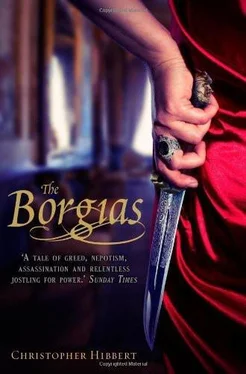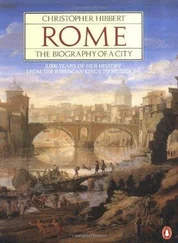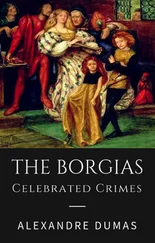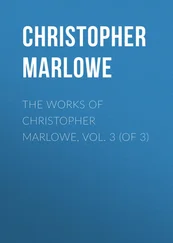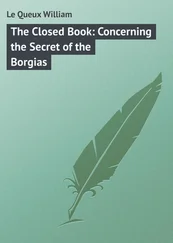Meanwhile, inside the palace, Lucrezia was received by her father, accompanied by thirteen cardinals and by her brother Cesare, and the ceremony began. The sermon, which was delivered by the bishop of Adria, a nephew of Duke Ercole, was long and tedious: ‘His Holiness,’ reported Burchard, interrupted the bishop several times, ‘repeatedly urging him to hurry through more quickly.’ The bishop, however, was not to be hurried; and it was some considerable time before he came to the conclusion of his address.
When the sermon was finally over, a table was brought out and placed in a suitable position in front of the pope. Ferrante d’Este, acting as proxy for his brother the groom, ‘brought Donna Lucrezia to His Holiness and, in his brother’s name, presented her with a golden ring,’ and Cardinal Ippolito ‘brought in four other rings of great value, a diamond, a ruby, an emerald and a turquoise together with a small casket, which was placed on the table and, by the Cardinal’s order, opened.’
The box contained a glittering collection of the Este family jewels, a veritable trove of treasure: two beautiful caps, one of which was ‘studded with fourteen diamonds, as many rubies and about 150 pearls,’ four jewelled collars, one jewelled pendant, several bracelets, ‘four of which were of very great value,’ four strings of large pearls, and four jewelled crosses studded with diamonds. The exquisite jewels, valued at 8,000 ducats, were now given to Lucrezia by the cardinal, who promised her more of the same from her new father-in-law. These jewels, however, were evidently not intended as a gift but merely as a loan, so that the duke, as one of his envoys wrote, ‘need have no anxiety,’ adding that ‘the document regarding this marriage simply states that Donna Lucrezia will be given the bridal ring as a present, and nothing has been said of any other present.’
The bride ‘with her ladies and many others all remained in the palace until five o’clock the following morning,’ and the festivities continued for the next few days. ‘The following night,’ reported Burchard, ‘a number of comedies were recited in the Pope’s apartments, and ballets performed, with some singing as well.’ One play performed in the Sala del Pappagallo had been inspired by the work of the Roman poet Virgil, and it starred two young men playing the parts of Cesare and his new brother-in-law as rulers of the lands of the Po.
On Thursday, December 30, there took place, one after the other, the races of the Barbary horses, of the Spanish jennets, and the fillies. This day of racing was one of the highlights of the Carnival festivities, eagerly anticipated by the Roman crowds, who thronged the streets to watch the spectacle, and by the betting touts who stood to make fortunes from the gullible punters.
This particular year, according to Burchard, ‘there was a great deal of violence and injustice.’ The winner of the first race was the Arab horse belonging to the Marquis of Mantua, ‘but it was not awarded the prize because it had lost its rider, who had clumsily fallen off at the start of the race,’ leaving as the winner the Arab belonging to Cesare. Burchard did not record whether the unfortunate rider had been unseated deliberately, but there must have been many in Rome that night discussing Cesare’s manner of winning the next two races.
One of Cesare’s staff had won the race of the Spanish jennets ‘most unfairly,’ as Burchard reported. ‘The horse did not begin in the course with the others on the Campo dei Fiori but ran out of a house beside the vice-chancellor’s residence as the others arrived, thus getting a lead on them and winning the prize.’ The fillies race was equally suspicious. ‘During the race, when the horses were on the Ponte Sant’Angelo, one of Cesare’s grooms crossed the course on his horse, stopped the mare who was in the lead and forced its rider out of his saddle.’
On January 1 the usual parade of Carnival carts took place, and the theme this year, not surprisingly, extolled the virtues of the dukes of Valence and Ferrara in the guise of Julius Caesar (Cesare) and Hercules (Ercole), in a series of tableaux that were paraded on wagons not in the usual setting of Piazza Navona but against the much grander backdrop of St Peter’s. The piazza was then barricaded to serve as the stage for a bullfight. Eight bulls and one buffalo were killed — four more bulls and another buffalo were spared for a similar spectacle on the following day.
The day was approaching when Lucrezia would leave Rome forever. On the morning of January 6, 1502, the Feast of the Epiphany, she went to bid farewell to her father. Her dowry had been formally counted the night before and handed over to her new brothers-in-law, Ferrante and Sigismondo d’Este. In the Sala del Pappagallo, Lucrezia, Cesare, and their father spoke quietly together in Spanish. As fond of them as she had always been, she bore the parting as she bore all partings, with her usual equanimity.
Mounting her horse, she rode out of the Vatican, flanked by Cesare and Cardinal Ippolito and escorted by a huge procession; ‘she was not wearing valuable clothes because it was snowing,’ reported Burchard. The pope was clearly deeply moved as he watched her leave, hurrying from window to window of the palace to catch a glimpse of the cavalcade until it was finally out of sight. He would never see his daughter again.
— CHAPTER 21 — The New Bride
‘LOOK AT THE GREAT LADY!’
THE BRIDAL CAVALCADE travelled slowly up the Via Flaminia in the gently falling snow. A few miles north of Rome, Lucrezia bid farewell to Cardinal Ippolito d’Este and her beloved brother Cesare, who returned to the city and the warmth of their own fireplaces, leaving Lucrezia to continue her long journey through the Apennines north to Ferrara with her own retinue, which numbered some seven hundred people, escorted by the five hundred men of the Ferrarese party that had travelled to Rome the previous December.
‘There was no bishop, nor protonotary, nor abbot,’ recorded a shocked Burchard, but Lucrezia was accompanied by her cousin Cardinal Francisco Borgia, whom Alexander VI had appointed legate to the Papal States. And to augment the party of Roman nobles travelling with her, Cesare had provided her not only with two hundred gentlemen from his own household, but had also ordered a number of musicians and clowns to entertain her on her way. As well as some 10,000 ducats for her expenses on the journey, the pope had provided her with a sedan chair, which she was to share with the Duchess of Urbino, from Gubbio to Ferrara. Lucrezia’s retinue was also impressive, including numerous squires and cooks, stable boys and dressmakers, and, of course, her own ladies-in-waiting, among whom, according to the reports Isabella d’Este received from her informant, were several beauties, one with syphilis, and ‘one Moor, the most beautiful woman I have ever seen.’
Providing mounts for all these attendants had proved a problem for the pope, who was temporarily short of funds after the spectacular expenses he had incurred in entertaining the Este party in Rome, and he had obliged all cardinals in the city to loan either two horses or two mules for Lucrezia’s journey — ‘none of these animals was returned,’ commented Burchard.
The long string of baggage animals winding its way through the snowbound passes of the Apennines was heavily laden. Strapped to the backs of several mules were the heavy padlocked chests containing Lucrezia’s dowry. Over one hundred mules were needed to carry her jewels, linen, and clothes; she took with her no fewer than two hundred expensive shifts and almost as many hats, one of which, according to Isabella d’Este’s informant, was valued at 10,000 ducats.
Читать дальше
